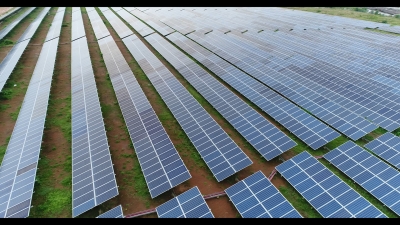Renewable energy share in India’s power mix likely to cross 35 pc by 2030: Report
By IANS | Updated: November 20, 2025 15:45 IST2025-11-20T15:42:24+5:302025-11-20T15:45:14+5:30
New Delhi, Nov 20 The share of India’s electricity generation from renewable energy (RE) capacity, including large hydro, ...

Renewable energy share in India’s power mix likely to cross 35 pc by 2030: Report
New Delhi, Nov 20 The share of India’s electricity generation from renewable energy (RE) capacity, including large hydro, is expected to cross 35 per cent by FY30 from 22.1 per cent in FY25, with expected incremental capacity addition of around 200 GW between FY25 till FY30, according to a report released on Thursday.
This, in turn, also hinges on the extent of implementation of the ongoing project pipeline where the projects are bid out and the PPAs are signed, the development of adequate transmission connectivity infrastructure as well as timely bidding for new RE projects, along with the power purchase agreements (PPAs) signing by Central nodal agencies, states the report by rating agency ICRA.
The outlook for the renewable energy sector remains “stable,” led by strong policy support, superior tariff competitiveness and sustainability initiatives by large commercial and industrial (C&I) customers.
However, challenges remain on the execution front, including land and transmission infrastructure, delays in signing PPAs, exposure to equipment prices and distribution utility finances.
After a sizeable RE capacity of 47.3 GW awarded in FY24, which is followed by 40.6 GW in FY25, the bidding activity has slowed sharply in the current year with only 5.8 GW awarded in 8M FY26. Further, the unsigned PPA capacity remains sizeable at about 40-45 GW as on date, based on an industry channel check, the report further states.
ICRA senior vice president Girishkumar Kadam said that “The decline in new project bids and delays in signing PPAs for large RE capacity by Central nodal agencies clearly reflects the concerns on the execution related to available transmission connectivity for the RE sector… a focus on the enhancement of both the storage capacity and grid strengthening within the state as well as at inter-state level in a time-bound manner remains extremely critical, as share of renewables increases in the generation mix.”
As India grapples with variability in renewable generation, Battery Energy Storage Systems (BESS) have emerged as the important enabler for grid stability. The Government has introduced viability gap funding for BESS capacity along with extended transmission charge waivers for storage projects until 2028, the report notes.
The Central nodal agencies and state discoms have awarded standalone BESS projects aggregating to over 20 GWh since April 2024 to October 2025. Also, the share of round-the-clock (RTC), firm and dispatchable renewable energy (FDRE) and solar plus storage projects remained high at around 90 per cent of the total RE capacity awarded in 8 months of FY26.
Further, the significant decline in battery costs over the past decade has helped reduce the cost of energy storage and adoption of BESS projects globally. Based on prevailing battery costs, ICRA estimates that the levelized cost of storage using BESS for 2-4 hours of storage is relatively high, in the range of Rs. 4.0-7.0 per unit, compared to Rs. 5.0 per unit for Pumped Storage Hydropower (PSP) projects.
This has seen a significant improvement from the level of over Rs. 8.0-9.0 per unit seen in 2022. While BESS costs for 4-hour storage remain higher than that of the PSP, the execution risks and gestation period for the BESS projects are relatively lower, the report states.
Commenting further on the competitiveness of standalone BESS projects, Kadam said: “Although BESS projects have shorter lifespans and require replacement capex, sustained reduction in battery prices is expected to drive greater adoption".
Disclaimer: This post has been auto-published from an agency feed without any modifications to the text and has not been reviewed by an editor
Open in app